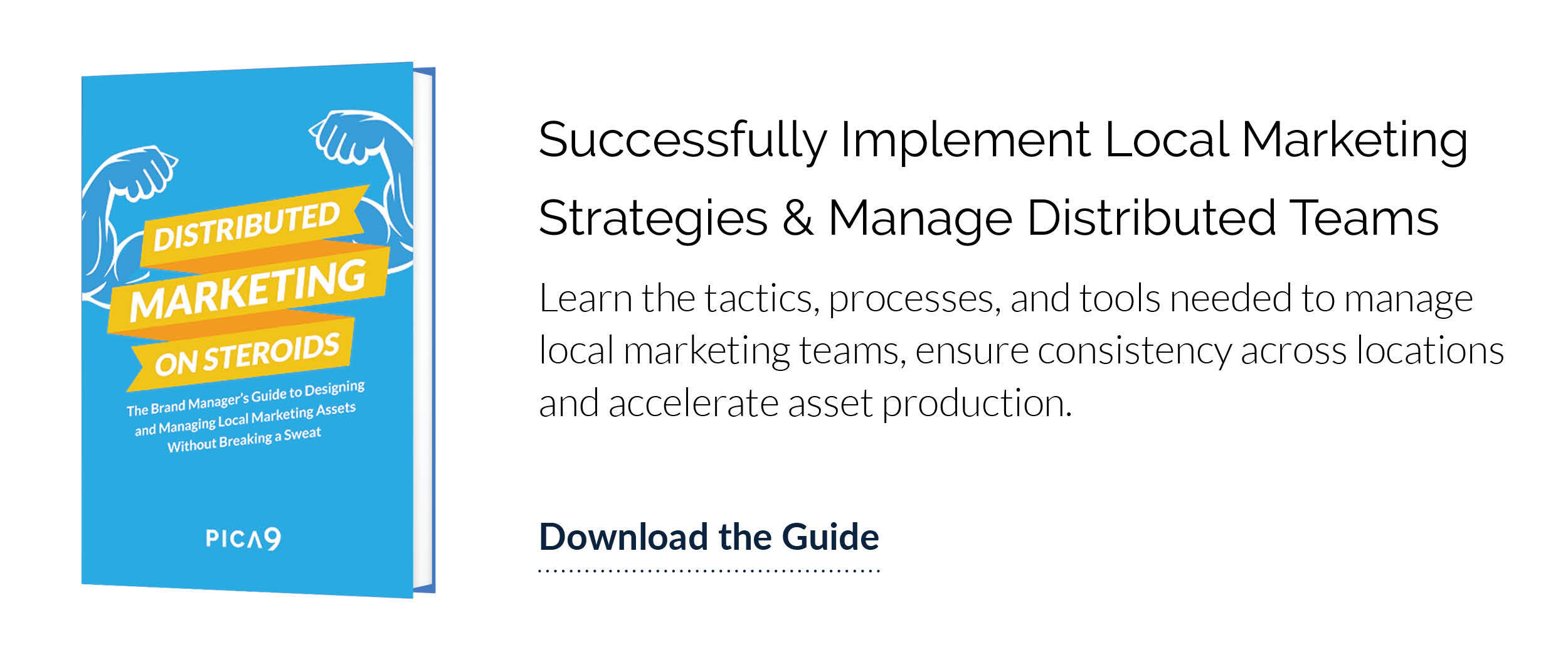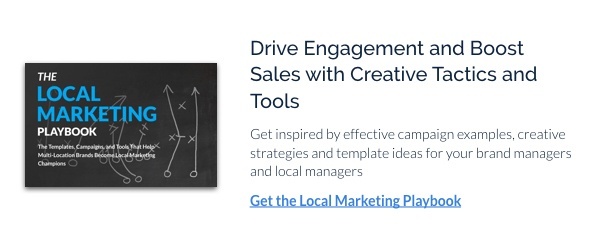How often has your brand management team poured heart, soul, and budget into a campaign that your local affiliates don't care about? Watching marketing assets go unused is frustrating and expensive. Gartner estimates that the average enterprise business spends 10-13% of their total revenues on marketing. If your franchisees, dealerships, or local outlets aren’t putting assets to work, the costs add up quickly.
In other cases, you may feel frustrated when you stumble across examples of non-compliant marketing in the field.
Maybe your dealership partners modified your direct mail templates and added a crazy discount to your product while featuring a competitor’s product right next to yours.
Perhaps some of your franchisees went completely rogue and downloaded a pixelated brand logo from Google that they put up on a custom-designed sign.
Or, none of your local outlets are using your beautifully designed email marketing templates and instead use freebie tools to reach out to customers.
What gives?
The 7 Deadly Multi-Location Marketing Sins
Local outlet owners and marketers have a lot on their plate - as can be expected when running a business. They’re crunched for time, and often so busy they're unable to plan ahead. From their perspective, doing “something” for marketing (even if it's less than perfect) is better than nothing.
Distributed brand management teams often work well into the future, planning next quarter’s strategy, campaigns, and budget. Local marketers are often lucky to know what assets they need next week.
Understanding the perspective of your local outlets helps brand managers see the importance of speed in the marketing process. Your local marketers need to work quickly and efficiently because they’re often down to the wire.
Time is just one of many reasons that brand management teams and local marketers end up on wildly different pages. When your worlds don’t quite align, your organization could experience one or more of the seven common distributed marketing mistakes we outline below. While some of these mistakes have mildly embarrassing outcomes, others could be costly and maybe even illegal. Read on to learn these common local marketing management errors and how to avoid them.
1. Brand Manager Says “Helvetica," Local Marketer Hears “Comic Sans”
Miscommunication is one of the most frustrating realities for members of a distributed organization. Misunderstanding in this environment is often a result of information overload. Brand managers should be careful to avoid overwhelming local marketers with unnecessary info. Dan Monaghan writes that effective communication between franchise owners and franchisees, "is about sharing ideas and best practices, and having a method for feedback and input."
If your local affiliates aren’t getting the message, investigate why:
- Were they given a massive document that was too lengthy to read?
- Was the information posted to your company intranet, while the assets they needed were in a totally different place?
Communication breakdowns can occur for countless reasons, but brand managers should make sure it’s never hard for local affiliates to find the information they need and fast.
2. Local Marketers Take Design Control Into Their Own Hands
How many times has your logo been misused in local advertising?
We’ve all seen horrifying examples of visual branding gone awry. A local outlet may attempt to resize a thumbnail-sized logo, which results in a blurry or pixelated look. Maybe that logo is then thrown on top of a document someone put together with Comic Sans in Microsoft Word, like an “out of order” sign, and screams "amateur."
These distributed marketing mistakes are all too common, and they can have a really negative impact on your brand’s image. While logo abuse and questionable font choices can happen for many reasons, it’s generally a problem that emerges when locals are unable to find an asset quickly, or there isn’t an asset that meets their needs. Disorganized digital asset management (DAM) is the #1 cause of these lamentable mistakes.
3. Local Marketers Use Last Year's Campaign Concepts
What happens when a local marketer runs a campaign from last year? Or modifies your asset so it’s really not the same advertisement that your customers are seeing on a national scale? These missteps can occur for many reasons, but as Flint Analytics writes, they're mostly caused by dissatisfaction.
Your local marketers may be unhappy with:
- How well your distributed brand management team understands their market
- The effectiveness of national campaigns at driving local sales
- How your results stack up to their own non-sanctioned efforts
- Ease of use for your digital asset management technologies
In some cases, your technology might not even make it clear which campaign they should be using. If locals are digging through endless folders on a FTP site, trying to figure out which email template is intended for "Summer 2017," they’re bound to get frustrated. At distributed brands, with exceptionally poor collateral management practices, non-standard campaign use might not be intentional at all.
4. Your Marketing Messages are Off and Sales are Dropping
Effective marketing makes customers feel like they’re understood and appreciated by a brand. Marketing that’s off-target can leave a negative impression. Consumers may even feel offended or annoyed if a brand’s advertisement misses the mark wildly. For 93% of customers in the US, feeling mistargeted by a brand has lead to long-term relationship damage.
Audience mistargeting within a distributed brand can occur at the national level or the local level - but, in the customer's eyes it's all the same. From your consumer’s perspective, bad marketing is bad marketing, and it will cast your entire organization in a negative light.
Local outlets interact with their target market on a daily basis, yet they don't always have a marketing background to effectively reach their audience. If your brand management team provides a campaign that doesn't meet the practical needs of the local outlets, your local marketers may not have the experience needed to recognize the issues. They will see that the messaging is not working, or backfiring, and take asset creation into their own hands. Providing channels for your local marketers to alert head office when campaigns aren't proving effective or are mistargeted for their local customers.
5. Local Marketers are Making Illegal Marketing Claims
Your brand management team works hard with your legal counsel to make sure the campaign materials provided to your local franchisees, dealers, and outlets are compliant with FTC advertising regulations. By the time your assets are available to local teams, you’ve received necessary input to ensure all of your claims are evidence-based, your ads are truthful and you’ve added all required disclosures.
But what happens when a local outlet takes the template and rephrases your claim to promise life-changing benefits? You local outlet and brand could be subject to expensive fines, corrective advertising requirements, or other FTC penalties.
The smartest way to avoid this dangerous distributed marketing mistake depends on how highly-regulated your industry is. For some brands, providing templates with locked content ensures that locals are not removing legally required disclosures. In more highly-regulated industries, you may choose to require approval from your counsel through a local marketing automation (LMA) tool before affiliates can deploy assets.
6. You Have Entire Regions Missing Critical Campaign Assets
If you’re manually providing asset access for your local partners, human error is almost guaranteed to occur. For brand management teams using a series of FTP sites, or other convoluted methods of collateral management, a major mistake could happen sooner rather than later. The result could be entire regions, or teams, of your local outlets missing assets they need for the campaigns.
How do you avoid this mistake?
By using better tools for asset distribution.
While you definitely want flexibility in your digital asset distribution tools, you also don’t want so much manual effort that there’s a huge margin for error. With an LMA tool that allows brand managers to set permissions, you can ensure that nobody in your affiliate network is ever completely out of the loop.
7. Your Locals are Suffering from TMA: Too Many Assets
Distributed brand managers often have the orchestration skills to conduct a world-class symphony. They’re masters at thinking about hundreds of different competing factors, and managing highly complex national campaigns. When you’ve developed a campaign concept, it’s natural to want to design gorgeous variants of your campaign with print assets, emails, social media, web pages, digital banners and dozens of other assets.
Your local marketers may open the FTP folder, and immediately feel overwhelmed. How on earth are they supposed to know which of the 15 emails get sent first, or which of the three options for a website banner is the best choice for their audience? They may make poor decisions, cut corners trying to customize too much content or ignore the campaign entirely.
To avoid overwhelming your local marketers with too many assets, you want campaigns that are simple to understand. This might be 5 assets in total, consisting of 3 print materials, an email, and a rate card that can be run simultaneously. Pick a single idea, and encapsulate it in as few assets as possible to avoid the phenomenon of asset overload.
How Can Brand Managers Empower Local Marketers?
The goal of distributed brand management isn’t to exert maximum control. It’s to power your local outlets to make the right decisions about campaigns, content, brand identity and everything else they need to drive sales for their business. In general, this requires brand managers to make their local marketers feel as if they’re involved without overwhelming them. With technologies and feedback structures that empower local outlets to make the right decisions, and apply their local branding with confidence, you can avoid many of the most common distributed marketing mistakes.
As a distributed marketing platform with strong templating and digital asset management (DAM) capabilities, CampaignDrive is built to help brand managers and local marketers avoid miscommunication and asset distribution issues. With print, digital, and email templating tools that allow distributed brand management teams to lock and unlock asset fields, you can ensure that your local affiliates have exactly the right amount of editing power.
CampaignDrive functionality is an important example of how technology can support the needs of both local marketers and brand management teams while enabling both groups to achieve their goals. Designed for even the toughest multi-location marketing challenges, CampaignDrive enables local marketers to succeed while giving brand managers optimal control.
Interested in how brands like Marriott, The Melting Pot, and Polaris make distributed marketing so easy? Learn their secrets in our free eBook Distributed Marketing on Steroids: The Brand Manager’s Guide to Designing and Managing Local Marketing Assets Without Breaking a Sweat





